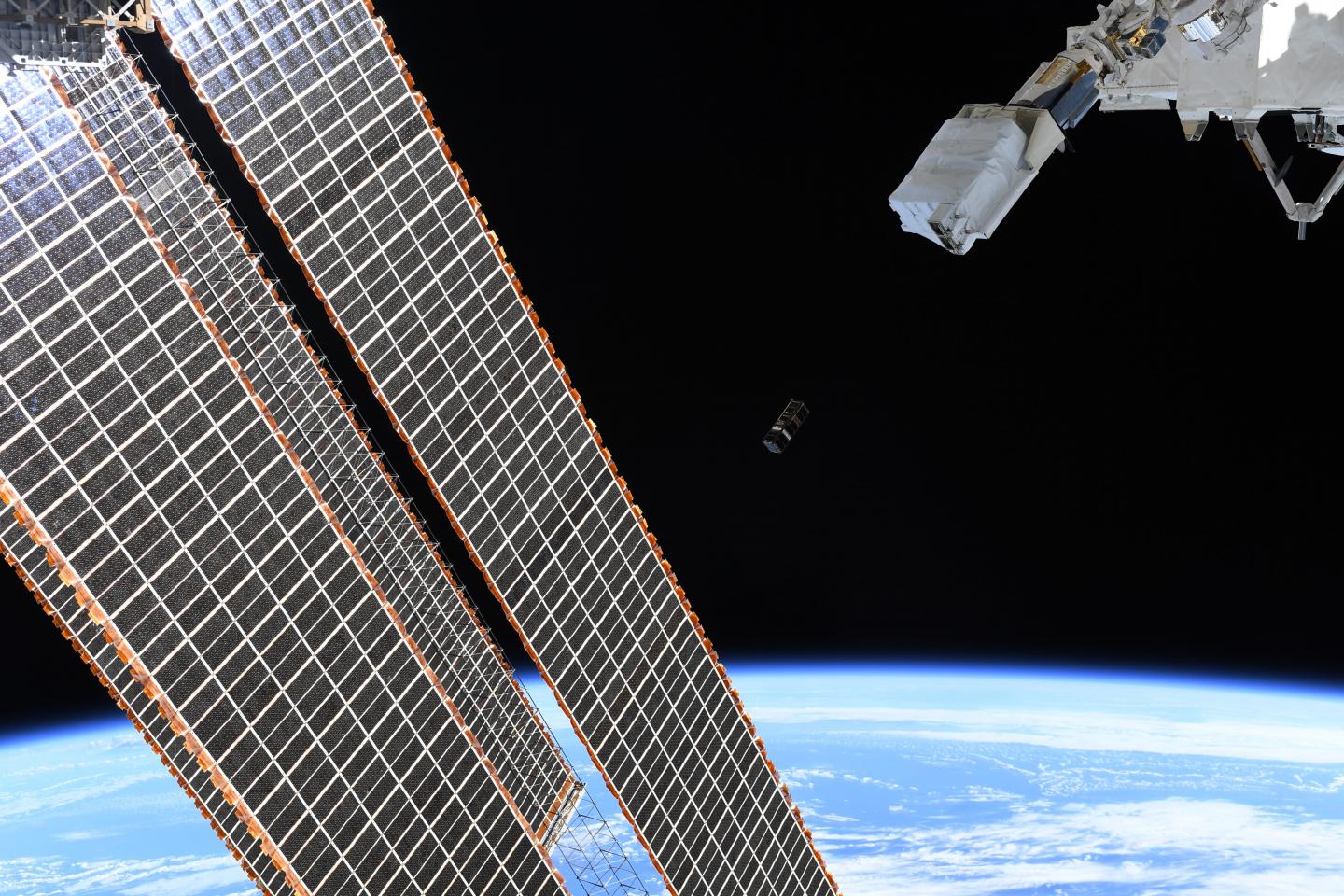The National University of Singapore’s scientific satellite brings into space a message from The Golden Record 2.0, a play written for the NUS Arts Festival

Credit: NASA
A satellite built by the National University of Singapore (NUS) entered orbit in June carrying both a high-tech quantum device from the Centre for Quantum Technologies (CQT) and a quotation from a play written for the NUS Arts Festival.
SpooQy-1, as the satellite is known, is testing a quantum light source that could enable future secure communication. Building on three years of art-science collaboration between CQT and the NUS Centre for the Arts (CFA), it also carries a quote from The Golden Record 2.0, first performed in 2018.
A new iteration on this play will be staged on 18 October this year as one of the NUS events marking Singapore’s bicentennial year.
The Golden Record 2.0 was inspired by the two Voyager spacecraft launched by NASA in the 1970s. These two craft are ferrying messages about Earth and humanity engraved into golden records out of the solar system.
Given the opportunity to select sounds, images and greetings that portray life on earth, what message would Singaporeans choose to communicate to the universe? That was the prompt for the innovative theatre project undertaken by the NUS Stage student group, with Director Edith Podesta and writer Corrie Tan.
The play’s script was assembled from interviews with some 30 people of different ages and backgrounds in Singapore, including students, a poet, a former director of the Singapore Zoo, a housewife, the President of The Astronomical Society of Singapore, a domestic worker and Professors of Law, English Language, Pharmacy and Biochemistry, among others.
CQT Principal Investigator Alexander Ling, who is also an Associate Professor in the NUS Department of Physics, was also among those interviewed. He leads the team that built SpooQy-1, a project funded by the National Research Foundation, Prime Minister’s Office, Singapore.
Work on SpooQy-1 has led to a spin-off company called SpeQtral, which is developing quantum communication technology for space. The startup recently announced US$1.9 million in seed funding from international and Singapore-based investors.
In the play, Assoc Prof Ling speaks on the motivation for developing missions for space: “You can talk about the spin-offs, about the technology that comes with it, but it’s really curiosity driven…. I’m hoping that, as a scientist in NUS, I am part of the slow cultural change where people actually think of these fundamental questions with a bit more sense of wonder.”
CQT Director Professor Artur Ekert says “Scientists and artists have in common that they are curious explorers of the world. Through our collaborations, we hope to inspire more people to share our appetite for learning. Even people who think they aren’t interested in science may find they appreciate its value when they encounter it through the arts – and vice-versa.”
Assoc Prof Ling’s team, in partnership with the NUS CFA, selected a quote from The Golden Record 2.0 to engrave onto the outside of SpooQy-1. The quote is etched into an interstage panel – a 10cm by 3cm plate of aluminium that forms part of the standard structure of the shoebox-sized satellite.
“We are all different nationals, we are entangled together with all the races,” reads the quotation from Mrs Santha Bhaskar, Artistic Director of the NUS Indian Dance group and a recipient of the Singapore Cultural Medallion.
The selection of Mrs Bhaskar from the many voices in the play honours her long-standing contributions to NUS CFA and her previous collaboration with CQT. She choreographed a new work called Sambhavna that was staged in the 2016 and 2017 iterations of the NUS Arts Festival and was appointed as a CQT Outreach Fellow for the two-year development of that project.
“As we mark our national bicentennial, Mrs Bhaskar’s quote celebrates the strength of Singapore’s diversity and a hope for such understanding in a globalised world,” says NUS CFA Director, Sharon Tan. “This collaboration with CQT for The Golden Record exemplifies our efforts in encouraging cross disciplinary projects in NUS.”
The device inside SpooQy-1 is designed to create the quantum property of entanglement between pairs of light particles, as a route to creating encryption keys. The satellite gets its name from this, as Einstein once described entanglement as ‘spooky action at a distance’.
SpooQy-1 was launched to the International Space Station (ISS) in April, arranged by Singapore Space and Technology Association through its partnership with the Japan Aerospace Exploration Agency. On 17 June, astronauts on the ISS launched the satellite into orbit using a deployer onboard the Kibo science module of the Space Station.
Researchers at CQT have been in daily contact with the satellite since. On 2 July, they switched on the satellite’s scientific instrument to start making entangled light.
The scientific payload and Mrs Bhaskar’s quotation will be in orbit for approximately a year, while the team gathers data on the quantum device’s performance. SpooQy-1 will eventually fall into and burn up in Earth’s atmosphere.
###
The Golden Record 3.0, the next installation of the NUS Stage theatre work, will be staged on 18 October and directed by Edith Podesta. Tickets will be available in early August via https:/
Media Contact
Jenny Hogan
[email protected]




